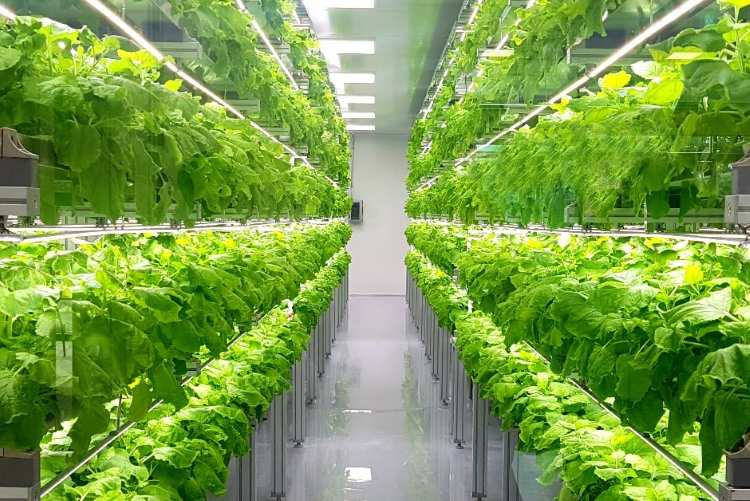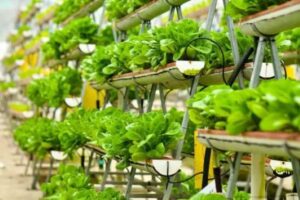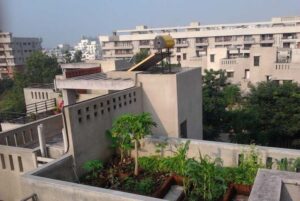
In a country where 1.4 billion people jostle for space, the battle for land is no longer just a metaphor. We use land to build, bury, drive, and, most crucially, to feed ourselves. But the way we farm is not just outdated, it is causing environmental damage. More than half of India’s land is under cultivation, and agriculture consumes around 90% of its freshwater. It is time we asked an uncomfortable question: can we continue to grow outwards to feed our population? Or must we now grow upwards?
India urgently needs to embrace vertical farming, especially in urban areas, not as a quirky new-age hobby but as a central pillar of its food security strategy and climate action. As the global population races toward 9.7 billion by 2050, the UN estimates that food production must rise by 70% compared with 2009 levels. But the land to grow that food—and the environmental headroom to do so—is simply not there.
Conventional farming is a heavy polluter. Globally, agriculture contributes to one-third of greenhouse gas emissions and is the single biggest driver of deforestation and biodiversity loss. Report after report tells us that our current method of food production is cannibalising the planet. Fertilizer runoff creates aquatic dead zones; pesticide residues pollute groundwater; inefficient irrigation depletes aquifers. And yet, the default solution remains to clear more land, dump more chemicals, and dig deeper wells. This is not a path to food security; it is ecological suicide.
READ I India’s manufacturing gamble needs a strategic reset
Vertical farming — a low-carbon solution for India
Vertical farming offers a way out of this trap. By growing crops in stacked layers under controlled conditions—using hydroponic or aeroponic systems—we can grow more with less. According to the latest global studies, vertical farms can produce 3.5 times more food per square metre than traditional agriculture, while using up to 90% less water and 50% less fertilizer. These are not pie-in-the-sky projections. Tesco, the British retail giant, is already sourcing strawberries year-round from vertical farms that operate without soil or sunlight, but with dramatically lower emissions and inputs.
This is a farming revolution tailor-made for India. First, because we are rapidly urbanising—by 2030, over 600 million Indians will live in cities. Feeding these urban centres through long supply chains is both expensive and polluting. Fresh vegetables and fruits trucked from rural farms to cities spoil easily, require refrigeration, and clog up urban markets with waste. Vertical farming can bring production into the heart of the city—on rooftops, in shipping containers, in repurposed warehouses—cutting transport emissions, reducing spoilage, and delivering fresher food.

Second, vertical farming enhances food system resilience. India’s conventional agriculture is vulnerable to monsoons, droughts, and increasingly erratic climate patterns. Controlled-environment agriculture insulates crops from these risks. Whether it’s 45°C outside or raining cats and dogs, your lettuce indoors will still grow with clockwork precision. Year-round production is not a luxury—it is an insurance policy in a warming world.
Third, it democratises access to safe food. In a city where pesticide-laden spinach and chemical-ripened mangoes are the norm, vertical farming can deliver clean, chemical-free, nutrient-rich produce. Unlike conventional farming, which relies on harsh chemical inputs, vertical farms often use zero pesticides thanks to their sterile, closed-loop environments. For middle-class families concerned about health and nutrition, this is a game-changer.
Now, some critics may scoff: Isn’t vertical farming a rich man’s toy? Aren’t the energy costs too high? Is this even scalable in a country with frequent power cuts and tight capital markets? These concerns are real—but also manageable.
Challenges for India
Yes, vertical farms require initial investment. But technology costs are falling rapidly. In fact, a McKinsey study projects that connected agriculture, including CEA, could add $500 billion to global GDP by 2030. Indian entrepreneurs are already responding. In cities like Bengaluru and Mumbai, startups are using rooftop hydroponic units to supply lettuce, basil, and microgreens to urban consumers. With the right incentives—low-interest green loans, solar power integration, and public-private innovation hubs—India can scale this up dramatically.
Let’s take a cue from Singapore, a land-scarce island that now produces 90% of its leafy greens through rooftop and vertical farms. Or look at Tokyo, where the Pasona Urban Farm grows vegetables inside an office building. What these cities show is that farming need not be rural or horizontal—it can be local, vertical, and high-tech. India, with its IT prowess and swelling urban markets, is better placed than most to lead this transition.

The government, too, must rise to the occasion. Urban farming should not be a CSR afterthought or a side project in smart city plans. It must be treated as essential infrastructure—like power, water, and waste management. The National Urban Livelihoods Mission (NULM) already includes provisions for urban agriculture. These must now be expanded into a full-blown vertical farming policy with incentives for rooftop farms, zoning rules for agri-buildings, training for young agri-tech entrepreneurs, and integration into city food supply systems.
Moreover, vertical farming aligns perfectly with India’s net-zero ambitions. Agriculture remains one of the hardest sectors to decarbonise, and vertical farming helps by shrinking the footprint of land, water, and carbon all at once. A typical vertical farm eliminates the need for tractors, ploughs, and irrigation canals. It removes long truck hauls from field to fork. It localises food systems in a way that nothing else can. And, crucially, it protects forests—our natural carbon sinks—from further encroachment.
In the end, vertical farming is not a silver bullet. It won’t replace wheat and rice cultivation in Punjab or Madhya Pradesh. But it can and should become a cornerstone of how we produce perishable, high-nutrition crops—like leafy greens, herbs, strawberries, and tomatoes—in cities and peri-urban areas. It complements rural agriculture, it empowers urban entrepreneurs, and it greenifies our cities.
The choice before us is stark. We can continue flattening forests and pumping aquifers dry in pursuit of food security. Or we can look up—to the skies, and to the stacked shelves of tomorrow’s vertical farms—and choose a smarter, cleaner, and more resilient way to feed our nation.
